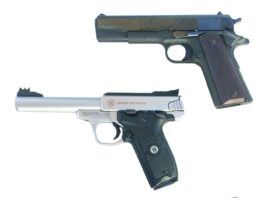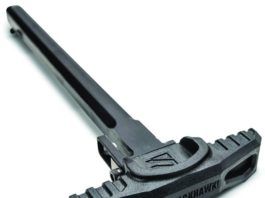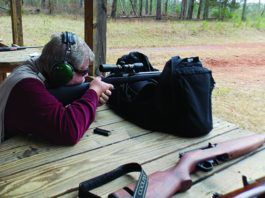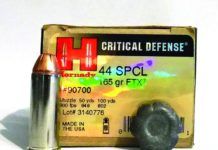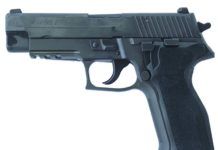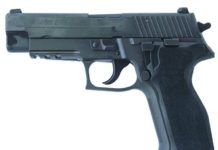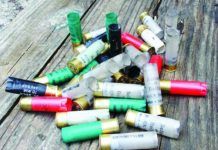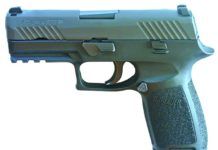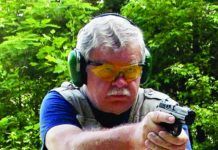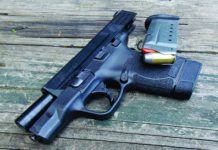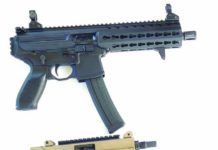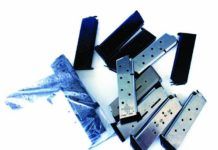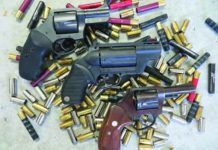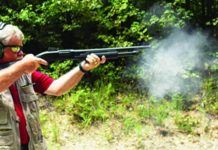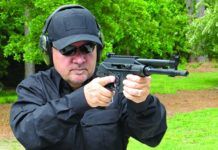The 44 Special: An Old Number Is Revitalized by Modern Loads
The 44 Special is a misunderstood cartridge. Never meant to be a powerhouse, the 44 Special was introduced as a counterpoint to the 44-40 WCF and the 45 Colt. A continuation of Smith & Wesson's 44 Smith & Wesson Russian, the more powerful 44 Special was intended to be a mild-mannered and accurate big-bore cartridge. Loaded with a 246-grain round-nose lead bullet at about 800 fps, the Special is mild enough and accurate in good, tight revolvers. Experimentation by enthusiastic hand-loaders vastly improved the power of the cartridge, but those trials also wrecked quite a few revolvers in the process. Once the 44 Magnum revolver was introduced, the need for such heavy loads was eliminated, in our opinion.
That doesn't mean the 44 Special is dead. In fact, it retains its reputation as a shootable, accurate round, and it finds a home in many 44 Magnum cylinders as a training round. But what of wheelguns chambered just for the Special? Are there powerful-enough loads out there to make it a backwoods-suitable carry gun? A recent test of several 44 Special loads suggests that the old round is rocking along quite well, thank you very much.
Some of the loads tested below are strong loads, probably best used in heavy-duty 44 Magnum revolvers. A 48-ounce Smith & Wesson Model 29 is docile when fired with the Cor-Bon 200-grain DPX load, as an example. Put the same load in the 36-ounce Model 21 Smith & Wesson, and recoil is on the upper end of what most users are able to tolerate. Further, in the Charter Arms Bulldog at 20 ounces, only lighter loads should be used. To assess the shooting-comfort range of various loads, our test guns this time included the Smith & Wesson Model 21-4 44 Special with a 4-inch barrel and the Charter Arms Bulldog with 2.5-inch barrel. This offered a mix of size, weight, and barrel length. We feel that it would have been pointless to fire these loads in a 44 Magnum revolver with a heavy barrel underlug and target grips and declare them controllable. The practical field and carry revolvers used in the test provide a thorough outlook on ammunition selection.
A Better Price on SIG P226 CPO
Just got my December issue, and the first thing I noticed was the Guns of the Year choice of the SIG Sauer P226R as the "Best in Class Pistol." Had to snicker. I got mine at Bud's Gun Shop in Lexington, Kentucky. And it was as good as yours. When I first looked at it, I did the field strip, and it looked brand new. I am not an expert on SIGs, but I carried a 226 in 9mm for many years. I was just happy to hear the same story on the Certified Pre-Owned model. The bit of a snicker I had was because I only gave $636 for mine, whereas you paid $725. I also bought a 357 SIG barrel for it, and I am happy to say it handles the 357 SIG as well as the 40 S&W you tested. Thanks for the great article.
2016 Guns & Gear Top Picks
Toward the end of each year, I survey the work R.K. Campbell, Roger Eckstine, Austin Miller, Robert Sadowski, David Tannahill, Tracey Taylor, John Taylor, Rafael Urista, and Ralph Winingham have done in Gun Tests, with an eye toward selecting guns, accessories, and ammunition the magazine's testers have endorsed. From these evaluations I pick the best from a full year's worth of tests and distill recommendations for readers, who often use them as shopping guides. These choices are a mixture of our original tests and other information I've compiled during the year. After we roll high-rated test products into long-term testing, I keep tabs on how those guns do, and if the firearms and accessories continue performing well, then I have confidence including them in this wrap-up.
Shotgun Shootout: Self-Loader, Pump, or Dual-Action Design?
When we decided to test three tactical shotguns suitable for home defense, rather than test three pumps or three self-loaders, we tested one of each, and one that could be either. The Benelli Nova Tactical Pump was our first type, followed by a semi-auto Mossberg 930 Tactical and TriStar's TEC-12, the latter of which can operate as a pump or semi-auto. If we were jumping into the sandbox at the moment, we think the Benelli M3 might be our choice, especially after firing the near clone of it, the TEC-12. However, the team thought the Benelli Nova pump had the simplest action to use well, and for us, its performance could not be faulted. The Mossberg 930 Tactical had its advantages as well, among them being it was the most comfortable shotgun to fire and use. We had our preference, as we describe below, but you may decide one of the others is better for you. To make that decision easier, our shooters went over the three guns with an eye toward finding flaws, and before we begin in earnest, we will say we found few problems, and that any of these three would do good duty for home defense.
We have had generally good luck with Benelli's Nova variations over the years. Way back in July 2007, we tested the field-grade Benelli Nova Pump 12 Gauge and gave it an "A-" for its overall performance, the feel and function of the synthetic stock and forearm, and its selection of choke tubes, which was impressive for this bargain-priced firearm. Then in the October 2013 issue, we tested a Benelli Super Nova Tactical No. 29155 12 Gauge. That gun earned an "A-" grade, losing out to a less expensive Stevens 320 that was every bit as good as the Super Nova and hundreds of dollars cheaper. Also, that Tactical Super Nova was the heaviest of those shotguns, which can be good or bad depending on the shooter and the load. But in that test, our shooters particularly liked the feel of the grooved polymer forearm and pistol grip. Downside: The out-of-the-box trigger pull of 8.75 pounds was too hefty for our tastes. Functionally, however, the Super Nova was fine. Those same likes carry over to a Benelli Nova H2O, which features a nickel-plated barrel, that we have not worked into a head-to-head against other corrosion-resistant units. Functionally, it has felt and operated like the other Novas we've tested, but the unit we've been shooting off and on (No. 20090, $669 MSRP) for a couple of years has open rifle sights (blade front and rear notch), which we don't like as well as the Ghost Ring sight on the Nova Tactical, and the price is a big step up from the plain black Benelli. At the time of this test, GanderMountain.com listed the H2O at $650, not including shipping and other charges such as FFL receiving fees. If you need the anti-corrosion features, you may be willing to pay the premium price for it, but for us, because of the price and the sights, we'd have to call the H2O a "B" in terms of value.
Bigger 9mms Handguns: SIG, Arsenal, and Beretta Go At It
As noted earlier in this issue, 9mm auto-loading pistols are among the most commonly purchased firearms in America for pleasure, competition, and defense. These guns are offered in many styles and price points, ranging from a few hundred to several thousands of dollars. While the handguns in this comparison are not top-end, highly customized pistols costing thousands of dollars, they are generally marketed as being well above average quality in fit, features, and capabilities.
In this comparison, we test five pistols, three of which were built by SIG Sauer, one by Beretta, and one newcomer from Arsenal. The SIGs tested are the classic P210, the P226 MK25 used by the U.S. Navy SEALS, and the relatively new P320. The Beretta tested is the recently updated M9A3. The fifth gun is the new Strike One from Arsenal.
For our evaluation, we used three different 9mm loads from three different manufacturers in two different weights and two different bullet styles. As always, the guns in question were shot by multiple testers (this time three men and three women) of different backgrounds.
We did our accuracy testing at Boyert Shooting Centers, an indoor range in Houston, and followed the standard accuracy protocol of collecting five 5-round groups at 25 yards from a rest for each pistol/ammunition combination. For this test, we also performed a speed drill. The speed drill involved starting from a low-ready position, shooting twice to the chest and once to the head of a silhouette paper target. This test was performed at 7 yards by one experienced tester with large hands. The speed test was performed after the familiarization shooting, but before the accuracy testing. The tester was given only one opportunity to perform the test. As these pistols are supposed to be superior to the average offering, our team expected above-average results and graded accordingly. Though all five pistols turned in good results and had their fans, the testing yielded one clear surprise winner.
Modern 9mm Subcompacts: CZ-USA, Glock, Steyr Compete
It goes without saying that compact and subcompact pistols chambered in 9mm Luger are a highly desirable form of personal protection. The 9mm offers acceptable ballistics without harsh recoil, and 9mm pistols from a quality maker are famously reliable. Also, 9mm compact pistols are often based on service-size handguns in the best renditions. The action and spring rates, and making certain slide travel and barrel tilt are compatible with the compact size, is important engineering. When done correctly, compact pistols are as reliable for practical use as any full-size pistol. Accordingly, our readers often ask us for reviews of certain pistols they've come across and may want to buy, if testing proves them to be worthwhile. So, this time, we line up a set of reader requests to go head to head at the range.
The first contestant was CZ-USA's 2075 RAMI B 91750 9mm Luger, $530. The RAMI is similar to the original CZ 75 but represents considerable engineering changes to accommodate the short slide and frame. The CZ 75 slide rides in the frame inside the frame rails, a design feature that some feel adds to the pistol's accuracy. This engineering lowers the bore axis as well, resulting in less muzzle flip compared to most double-action first-shot pistols. A tradeoff is that the slide is sometimes difficult to grasp and rack.
Next up was the Glock G43 Limited Edition ProGlo TALO Edition UI4350501, available for $489 from Slickguns.com. TALO is a wholesale buying cooperative that was started in 1965 by fishing and hunting wholesalers in Texas, Arkansas, Louisiana, Oklahoma. TALO commissions limited editions of firearms from Smith & Wesson, Colt, Glock, Ruger, and North American Arms and distributes them to stocking sporting goods dealers across the US. Shooters who want one of these special editions will need to contact their local dealer and ask him to order the special edition firearm from a TALO wholesaler. TALO firearms are often specially designed products with top-end accessories. An example came in 2006 with the Ruger John Wayne Vaquero. The first edition of 3500 units was featured as an American Rifleman's Magazine editor's pick. On this Glock 43, the pistol's slide is standard save for the sights, which are made by AmeriGlo and feature a brilliant orange post around a white-insert tritium front. The rear sight features a U-notch for rapid target engagement. The rear face of the rear sight is serrated to reduce glare.
The Steyr S9-A1 9mm Luger, $483 at BudsGunShop.com, isn't particularly more difficult to conceal then the RAMI, but it is not a pocket gun as the Glock 43 is. The Steyr S9A1 is a double-action-only handgun with a trigger action more Glock like than anything. The Steyr barely came in as the least expensive pistol tested. This is the largest pistol tested, but it is lighter than the RAMI due to the Steyr's polymer frame. More effort is needed to cock this pistol due to a combination of the slide design and a heavy recoil spring.
In accuracy testing from the bench at 15 yards, we used three loads. The Speer Gold Dot 124-grain +P Short Barrel hollowpoint load cost us $23/20 rounds at MidwayUSA.com. The Black Hills Ammunition 115-grain EXP ran us $14.57/20 rounds, also from MidwayUSA.com, and Winchester's 115-grain USA Forged steel shellcase FMJs came to us from Cabelas.com (prior to the buyout by Bass Pro) and cost $36 for 150 rounds. Following is how the pistols fired those rounds, along with comments by our hands-on testers.
Compact 45 ACP Shoot-Out: Glock, S&W, and Springfield
The compact self-loading pistol is easily the most popular personal-defense handgun in America. Shooters realize that small-bore handguns may not have sufficient potential for personal defense. The 9mm Luger is the baseline for personal defense in most shooters' eyes. The 40 S&W isn't as popular due to the stout recoil it produces in compact handguns. After all, many 9mms and 40s are built on the same frame. The 45-caliber compact is slightly larger, and the lower-pressure 45 ACP gives a hard push in recoil rather than the sharp jolt experienced with the 40.
To see how our shooters rated a trio of smallish 45s, we acquired three handguns based on the service-size Glock 21, Springfield XD, and S&W M&P handguns.
l From Glock comes the single-stack polymer-frame G36, which is popular, reliable, and well suited to personal defense. The Glock G36 PI3650201FGR 45 6R FS, $561, isn't the most popular Glock by a long shot, but a number of Glock fans, as well as 45 ACP fans, like the Glock 36 handgun for its simplicity and ease of use.
l Another gun in the test was Springfield Armory's XD-S, a downsized XD with a slim single-stack grip. The Springfield Armory XD-S 3.3 XDS93345BE 45 ACP, $419, is even more compact than the Glock, with a short grip frame and a five-round magazine.
l The latest arrival in the polymer-frame 45 single-stack scene is the Smith & Wesson M&P45 Shield 180022, $399. The Shield series have been popular and well accepted by concealed carry handgunners, so making a 45-caliber version of it is a natural choice.
We test-fired the pistols with a total of five loads. The first was a handload with Magnus Cast bullets (#803 225-grain Flatpoint) and 4.8 grains of Titegroup powder. Our other test loads came from CheaperThanDirt.com. One was the HPR 230-grain JHP 45230JHP ($38/50 rounds), a Hornady 200-grain XTP ($15.28/20), a Hornady 230-grain XTP +P 9096 ($16.25/20), and a Fiocchi 230-grain Extrema JHP 45XTP25 ($17.24/25). We fired the handload during the combat firing test stage, shooting 50 cartridges in each pistol. We also fired a magazine of the Hornady 230-grain +P in these stages to evaluate recoil in each handgun. The HPR 230-grain load, the Hornady 200-grain load, and the Fiocchi 230-grain Extrema were used in accuracy testing. During the course of our testing, the three pistols never failed to feed, chamber, fire or eject, so reliability isn't an issue.
As may be expected, these compact 45s are popular with fans of each company's full-size 45s. But that isn't the whole story. As we discovered, fans of the full-size Glock may prefer the XD-S and our Springfield XD fan preferred the Glock 36 compact, and so it went. The primary difference was in handling, we found. Here are our findings.
9mm Pistols: Uzi Mini Pro, MPA Defender, and SIG Sauer MPX-P
The civilian-available semi-auto versions of what began as expensive SBR's (short-barrel rifles) or true submachine guns are advertised as having good accuracy and reliability while offering a more compact package than a rifle and higher round counts than most handguns. For the task of guarding the castle, we've been around the block a time or two, and have suitable choices for nearly anyone — great pistols, rifles, and shotguns. For this test, we had to suspend any preconceived notions of what we might prefer for home defense and test these firearms based on their own merits. Those merits, we found, are few. If you are shooting for fun and simply making brass, anything that goes bang is suitable. We'll get into the reasons for these judgments, but we like to be clear up front. The SIG Sauer MPX-P is one expensive means of not accomplishing much. The Uzi Pro pistol has drawbacks that made shooting downright frustrating. The MasterPiece Arms Defender proved to be the best of the three and has merit in a defensive situation, within certain narrow parameters. We arrived at this decision by using personal-defense criteria as the overriding factor in providing Buy/Don't Buy advice to our loyal readers. So, in more detail, here are our reasons for making these assessments. Our 9mm Luger ammunition for this test included a 158-grain lead round nose choice from Tomkatammo.com ($18/50 rounds). We also used Black Hills Ammunition 124-grain jacketed hollow points from VenturaMunitions.com ($14/20), a Black Hills Ammunition 115-grain EXP, an Extra Power load not quite in +P territory, also available from VenturaMunitions.com, ($17/20), and a SIG Sauer 115-grain full-metal-jacket load from Cabelas.com ($28/50). Others included the SIG Sauer 124-grain V Crown jacketed hollow point from Luckygunner.com ($16.75/20), and the Hornady American Gunner 124-grain XTP +P from MidwayUSA.com ($14.79/20). We used the Tomkat 158-grain, the Black Hills 124-grain JHP, and the SIG 115-grain FMJ load in benchrest accuracy testing.
1911 Magazines: Some Are Good, And Some Should Be Avoided
Magazines for the 1911 pistol have evolved more during the past two decades than during any other time since the pistol's introduction. The bane of the 1911 is cheaply made magazines, with poor ammunition close behind. For many years, the only choices were Colt factory magazines, which were usually high quality, then GI magazines, and poorly made gun-show magazines. Some were marked COLT 45 on the base in bold letters, and these usually meant the shooter was the real deal. At a time when new Colt magazines were around $15, aftermarket magazines sold for as little as $4, and most of them were not worth the aggravation. GI magazines were good quality, but shooters often found them bent and worn out, unless they were new in the wrapper. Quite a bit of barrel feed-ramp polish and tuning of extractors went on that probably was tied to ammunition and magazine problems. Some of the aftermarket magazines were not properly welded. In other cases, the follower was too tight in the magazine body; and in other instances, the magazine springs were weak. Others had poorly attached buttplates, that gave way when dropped on the ground during IPSC competition. Some survived, others did not.
The basic construction of the magazine itself has changed from sheet steel to aluminum and plastic followers versus metal followers. We have examined quite a few magazines that invited a situation called false slide lock. The follower appeared to catch the slide lock, but the slide lock was actually on the wrong shelf, which isn't good for any of the parts. A 1911 feeds by the loading block on the bottom of the slide stripping the cartridge forward as the slide moves forward. The cartridge case rim catches under the extractor and is pressed forward. Some feel that it is a good thing that the bullet nose snugs a little over the feed ramp and bumps the cartridge case head into the breech face as the cartridge enters the chamber. Some magazines, notably the Wilson Combat, allow the bullet nose to strike much higher on the ramp, which results in missing the feed ramp's edges more so than others.
…
Big-Bore Snubnoses Around $500: Charter Arms and Taurus
We recently reviewed three 38 Special revolvers that cost about $400 and thought we would increase our budget and caliber size, and then sourced three revolvers each costing about $500 in three different big-bore calibers: 44 Special, 45 ACP, and 45 Colt, often called 45 Long Colt (LC) to ensure it's not mixed up with the Auto Colt cartridge. The three revolvers included two Charter Arms products, the Classic Bulldog in 44 Special and the newer Pitbull in 45 ACP, plus the Taurus Public Defender Polymer chambered in .410 shotshell and 45 LC.
Even though these were new revolvers, we still performed a range-rod test since there was a bit of side-to-side wiggle in the cylinders of all the revolvers. Range rods check the alignment of the chambers to the barrel bore. We also noted that the action of the Taurus seemed a bit stiff; our initial dry firing in double action found the cylinder would not fully index to the next chamber at times. Dry firing took care of the indexing issue, and all passed the range rod test. We also noted during the range-rod test the barrel of the Pitbull was not fully screwed into the frame. It was off by a fraction of a turn, enough to cock the front sight to the left when aiming the revolver. It is unacceptable that a gun leaves the factory in this condition. We anticipated and needed to use Kentucky windage with the Pitbull at the range.
In the past Charter Arms revolvers have been favorably rated, but in these two examples we found exception. The not-fully-screwed-down barrel was also the reason the cylinder-to-barrel gap was so large. We measured the gap between the front of the cylinder and the forcing cone at the rear of the barrel using feeler gauges from Brownells (606-950-252WB) and found a gap of 0.010 inches for the Pitbull and the Bulldog Classic and the Taurus at 0.005 inch. A gap of 0.003 inches is desirable for a competition revolver, but up to 0.006 inches is often found. A large gap allows more gas to escape, reducing the bullet's velocity. It also means there is more flash, and if the chamber and cylinder are not perfectly aligned, a user might experience splash from burning powders and bits of shaved bullet metal. We did not experience any splash with the Charter Arms revolvers. We did note that the Classic Bulldog had about 30 fps more than the published data for Hornady Critical Defense165-grain FTX bullet, which is 900 fps out of 2.5-inch barrel. The 3-inch barrel of Bulldog must have helped increase velocity. The Pitbull had noticeably less muzzle velocity compared to factory data. We assumed the reduction came because the Pitbull has a 2.5-inch barrel and the factory data for the cartridges use either a 4- or 5-inch barrel. Reduced muzzle velocity also occurred in the Taurus.
A common feature of all three revolvers was a safety transfer bar. This system prevents the hammer from striking the firing pin unless the trigger is pulled fully to the rear.
These revolvers are made for close-in work, but we still tested accuracy out to 25 yards. Since the Taurus offers the ability to fire .410 shotshells as well as cartridges, we sourced some CCI shot cartridges in 44 Special. CCI manufactures shotshells in 45 ACP, but warns against using the the cartridges in revolvers since the crimp that holds the shot in the cartridge case may interfere with the rotation of cylinder after being fired. One of our team members regularly carries a revolver loaded with bird shot cartridges and bullet cartridges when we walks his dog in the woods. He's equipped to deal with snakes as well as bears, depending on what chamber he lets fly.
Home-Defense Shotguns: We Compare Three Pump Actions
The shotgun is seen by many as the best choice for personal defense and especially home defense. The most powerful portable shoulder-fired weapon used for self preservation, the 12-gauge shotgun offers a multiple-projectile load that has been proven effective in close-quarters defense. With slug loads, it is even suitable for defense against large, dangerous animals. In rural defense, there are plenty of deadly predators in the country, feral dogs, mountain lions, and other dangerous animals that only an aggressive counterattack will stop. But without proper firearm and load selection, as well as training, the shotgun will be underutilized. More than one citizen has defended himself with the shotgun, and common sense tells us that we should have one in the home.
In this test, the shotguns we chose are among the best in their price range. The choices range from a pedestrian bead-sighted model to a tactical model with an AR-15 type stock. While self-loaders rule the day at 3 Gun competitions and are very reliable, a dirty pump will work when a dirty automatic will not. We have seen self-loaders malfunction during our test programs, and we know the pump-action shotgun is relatively easy to master, as long as you get quality training so you're confident in your skills and sure in your manipulation.
With this in mind, we chose three likely shotguns for home defense. The top end of the budget was $450, but we would prefer to spend less to get a good pump-action gun, if we could. We fired them with practice loads, home defense loads, good loads suitable for pest and predators, and slugs suitable for defense against large animals. We used five different loads for testing these shotguns. We tried to find the most economical offerings in bulk. This included the Fiocchi 12HV75 birdshot ($97 for 250 shotshells from CheaperThanDirt.com) Fiocchi 1-ounce Aero slugs ($8.10/10 from VenturaMunitions.com), Hornady 86240 Critical Defense 00 buckshot loads ($11.08/10 from CheaperThanDirt.com), Hornady's Varmint Express, a load using 24 pellets at 1350 fps ($16/10 from Gandermountain.com), and Winchester 3-inch 12-gauge 00 buckshot loads (No. XB12300VB, $17/15 from CheaperThanDirt.com) This selection covered the likely uses for personal defense, predators, and even large animals. Each shotgun was fired with 50 birdshot shells, 10 of each of the buckshot loads, and 10 Fiocchi slugs, for a total of at least 90 shells per gun. This is punishing work and was not accomplished in a single range session. We fired mainly the light-kicking birdshot to learn how to function the guns quickly and determine their smoothness and ergonomics.
Here are the results.
5.56mm Pistols from Kel-Tec, Spikes Tactical, and CMMG
It could be argued that the AR pistol evolved out of a desire and need for shooters to own a legal short-barrel rifle-caliber weapon without having to jump through BATFE hoops or pay for a tax stamp to own an SBR (short-barreled rifle). The difference between an AR rifle and pistol comes down to the pistol not being compatible nor able to attach a stock. We wanted to take a look at these AR pistols for home defense and other uses where a compact firearm makes sense, because they offer a number of benefits over a conventional AR rifle, mainly, being more maneuverable while being chambered in a rifle caliber and being compatible with common AR-15 magazines. We acquired three examples, a Spike's Tactical The Jack custom build, a CMMG Mk4 K, and a Kel-Tec PLR-16. The Spike's and CMMG are true AR-15 mechanisms reconfigured to a pistol, while the Kel-Tec uses a different operating mechanism. All three are chambered in 5.56mm NATO/223 Rem. and all are compatible with AR-15 magazines.
We tested these pistols for accuracy, performance, reliability, compatibility with a range of AR-15 magazines, maintenance, ability to be customized, and cost. We found that the Kel-Tec was inexpensive compared to the CMMG and Spike's Tactical pistols. The Kel-Tec, however, needed to be operated differently. The CMMG and Spike's were an easy transition from AR rifle to AR pistol. An AR pistol, as we found out, is nearly as effective as a full-size AR at close to mid range. With the right ammunition, they could be tuned to be a very capable home-defense choice for anyone in the family competent to operate a firearm. Namely, using frangibles to limit overpenetration through walls and doors while still supplying lots of pop.
The AR pistol's edge is its size, but it is also a disadvantage, as an AR pistol is not as easy to shoot as a rifle or a traditional handgun. They are large and require two hands to effectively deliver accurate shots. You could get off a few shots holding an AR pistol with one hand, but the weight of the pistol causes muscle fatigue. A typical full-size handgun may weigh more than 2 pounds loaded, compared to these AR pistols, which weighed from 3.2 to 6 pounds unloaded. Add a pound or more for a 30-round magazine, and you've got a sidearm that would wear out nearly anyone who didn't transport them with a sling, just as you would with a rifle. We used one of the SIG SBX Pistol Stabilizing Braces ($149; SIGSauer.com) and found we liked to use the brace differently than intended, which we will get into shortly.
We also fired the pistols using a Blackhawk Storm Sling ($33.95; Blackhawk.com), a single-point sling with a built-in bungee cord, which many team members felt was an excellent way to carry and control the pistol. We tested with three different AR-15 magazines, including a Brownells USGI CS (Brownells.com; $14) constructed of aluminum, and two polymer magazines, the Magpul PMag Gen2 (Brownells.com; $12.30), and the FAB Defense Ultimag (TheMakoGroup.com; $25). For fast reloads, we also used a Kydex AR magazine carrier from IBX Tactical (IBXTactical.com; $35).
Building an AR pistol is not just a matter of installing a short barrel in a upper receiver and swapping out the receiver extension/buffer tube. Short barrels lose velocity and provide less dwell time for the projectile, so manufacturers need to tune and time the mechanism. A short barrel also needs to work on a range of loads from low- to high-quality ammunition. Reliability can be an issue.
Hands down, the CMMG and Spike's offered more customization than the Kel-Tec because they are compatible with a range of AR-15 aftermarket products — triggers, rails, pistol grips, BUIS, and more. The Kel-Tec is not as compatible. Also, for those testers already familiar with an AR-15, the CMMG and Spike's were much easier to maintain. But there's much more to consider, which we relate below:



























